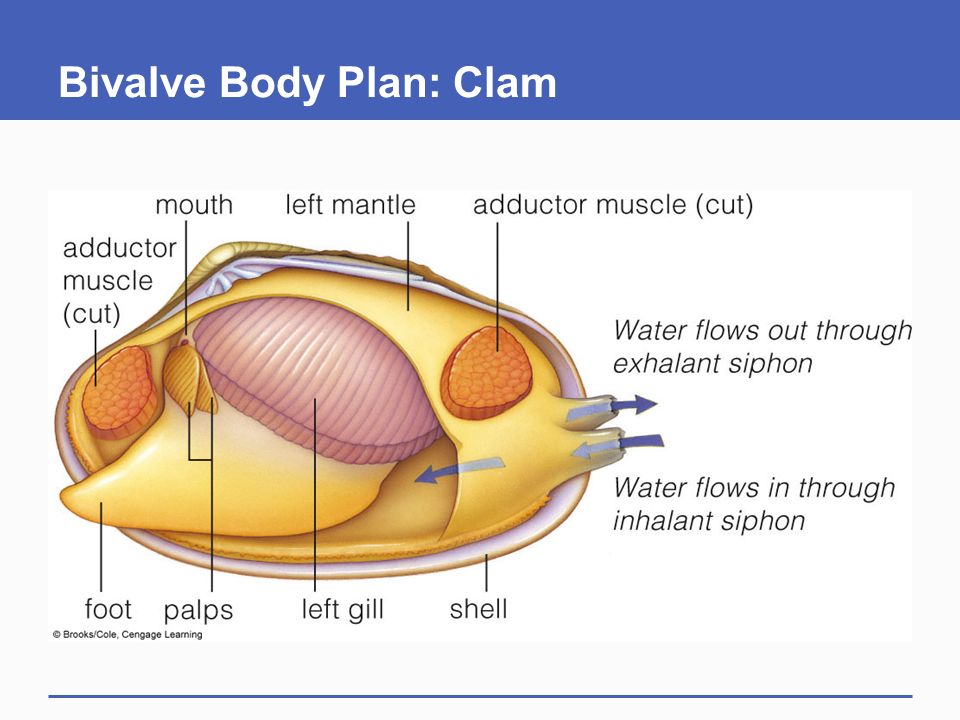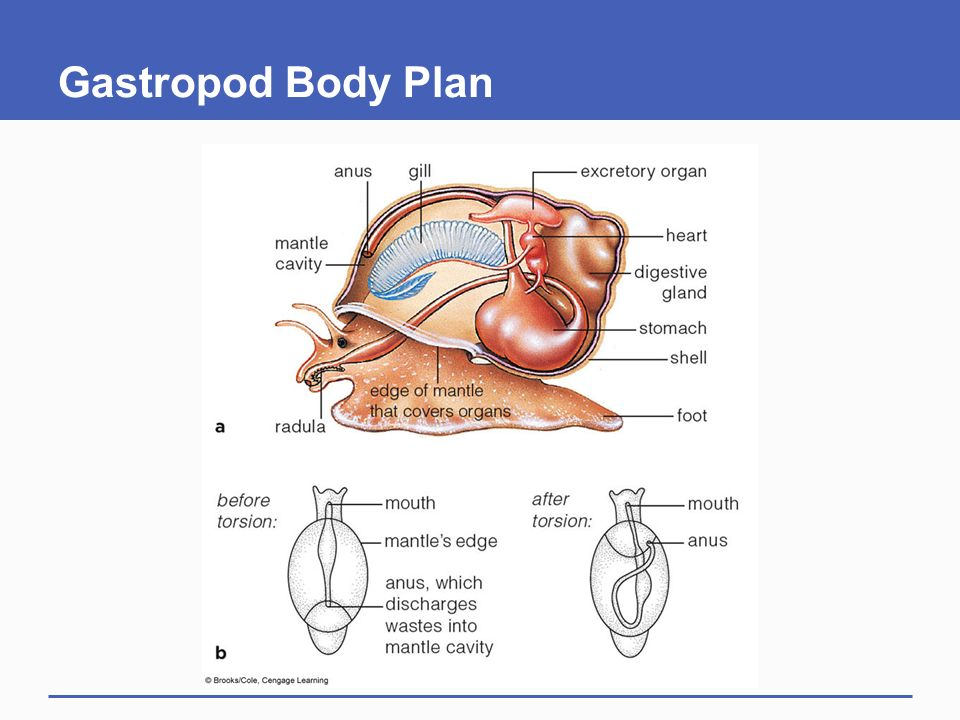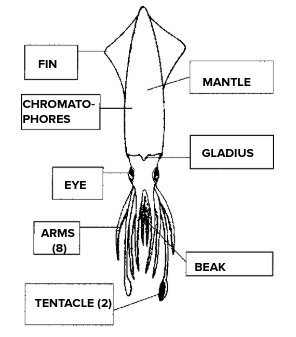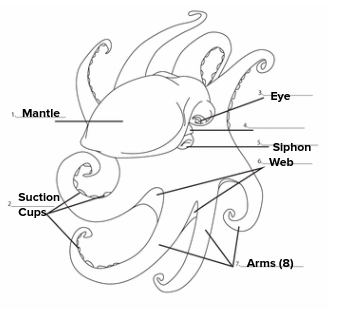Mollusks
- Mollusk Basics
- invertebrate
- soft, unsegmented body
- aquatic, damp environments
- most have external, calcareous shell
- calcareous = contains calcium carbonate, chalky
- 3 Classes of Mollusk
- Bivalve
- Gastropod
- Cephalopod
- Bivalves
- BI (Two) - Valve (shell)
- Shells hinged together at one end and are kept closed by a short, tough ADDUCTOR MUSCLE.
- Examples: Mussels, Clams, Oysters
- How does a bivalve build its shell?
- Within the mantle are SHELL GLANDS that secrete CALCIUM CARBONATE to produce the shell
- Rings can be used to calculate age
- How does a bivalve eat?
- Filter Feeders- filter their food from the water
- Siphon Tube
- Incurrent siphon – WATER THAT CONTAINS FOOD AND OXYGEN ENTER HERE
- Excurrent siphon – WASTE PRODUCTS OF DIGESTION AND RESPIRATION ARE ELIMINATED HERE
- Adaptations of bivalves to help with feeding
- Tough BYSSAL THREADS with sticky pads that allow them to bind to hard surfaces. (EX. MUSSELS)
- Oysters can secrete a CEMENT to help them bind to surfaces.
- How do oysters make pearls?
- A pearl begins to develop when a SAND GRAIN gets into an oyster and lodges between the mantle and the shell.
- The mantle tissue reacts to the sand grain as a FOREIGN BODY and secretes layers of shell around the grain forming a PEARL.
- Movement of bivalves
- Fastest moving bivalve is the SCALLOP
- also have about 60 blue eyes for sensing
- Move across the seafloor in sudden spurts by opening and closing quickly.
- Other Bivalves move through substrates (EX. Sand and MUD)
- Bivalves such as RAZOR CLAMS and SOFT-SHELLED CLAMS use their muscular foot to dig.
- Reproduction of bivalves
- Bivalves have separate sexes:
- FEMALES: release their eggs into the water.
- MALES: release their sperm to fertilize eggs.
- In the early stages of development, the bivalves exist as part of the PLANKTON community. Eventually, they develop their shells, sink to the bottom and mature into adults.
- Gastropods
- UNIVALVES: “ONE SHELL”
- Account for 2/3 of all mollusks
- Examples: Snails, conch, abalone, whelks
- Tentacles
- Gastropods have 2 sets of tentacles
- Upper (posterior): eye stalks
- used to respond to light
- Lower (anterior): sensory tentacle
- used for smelling and tasting
- help find food and avoid dangerous areas
- Redula
- tooth-like structures that scrapes off and ingest algae from surfaces
- Other Gastropods
- Sea Slugs and Nudibranchs
- Cephalopods
- Examples: Squid and Octopus
- Refers to the class of swimming mollusks that use JET PROPULSION for motion (through the siphon)
- Streamlined body shape
- Lack an external shell (soft-bodied)
- Invertebrates
- Over 800 living species
- Squid body plan
- Octopus body plan
- Cephalopod body parts
- Mantle
- main body of the squid
- protects organs
- made of muscle and skin
- Beak
- In addition to radula (tiny teeth), cephalopods have a large beak made of chiton surrounding its mouth.
- Used to chop and slice up prey before the food is passed.
- Shell
- Octopuses do not have shells. Over millions of year, the shell has been reduced to nothing.
- Squid, on the other hand, have an internal structure called a pen or gladius. This structure is made of cartilage and supports the mantle.
- Siphon
- Siphon (Funnel)
- muscular structure
- respiration, discharge of waste, propulsion
- Arms vs. Tentacles
- Arms: all arms are equal in length with suction cups lining their entirety
- Tentacles: longer than the arms and have suction cups only at the ends
Creature |
Arms |
Tentacles |
Suction cup purpose |
Squid |
8 |
2 |
grasping prey |
Octopus |
8 |
0 |
climbing |
- Eyes
- Cephalopods have eyes that are so well developed that they can see as well as people do.
- Chromatophores
- Allow for some species to change color to better help them to camouflage
- give skin its reddish-pink color
- when these cells contract, the skin appears paler
- under stress, may appear red
- to hide from predators
- to catch prey
- Intelligence
- Ink
- Most cephalopods are able to release ink as an escape mechanism.
- The ink is released from the ink sacs in the body and shot out of with a jet of water from the siphon.
- octopuses: black ink
- squid: blue-black ink
- cuttlefish: brown ink
- Other types
- Giant squid
- Cuttlefish
- Chambered nautilus



